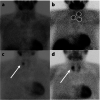Usefulness of 99mTc-SESTAMIBI Scintigraphy in Persistent Hyperparathyroidism after Kidney Transplant
- PMID: 34868377
- PMCID: PMC8602544
- DOI: 10.1007/s13139-021-00722-6
Usefulness of 99mTc-SESTAMIBI Scintigraphy in Persistent Hyperparathyroidism after Kidney Transplant
Abstract
Purpose: 99mTc-labeled sestamibi scintigraphy combined with single-photon emission computed tomography (SPECT) has a high positive predictive value for localizing hyperfunctioning parathyroid lesions in primary hyperparathyroidism (pHPT) but relatively low sensitivity and specificity in secondary hyperparathyroidism (sHPT) and tertiary hyperparathyroidism (tHPT). The purpose of this study is to investigate the usefulness of 99mTc-sestamibi scintigraphy in persistent hyperparathyroidism after kidney transplant (KT).
Methods: Retrospectively evaluated 50 patients who received parathyroidectomy after KT at a single medical center. The parathyroid lesion with the highest sestamibi uptake intensity of a patient was graded from 0 to 3. Uptake intensity was analyzed in correlation with parathyroid hormone (PTH), calcium, ionized calcium, phosphorus, and vitamin D.
Results: Per-patient analysis, 43 patients had hyperplasia, 6 patients had adenomas, and 1 patient had a carcinoma. Only 3 patients with hyperplasia did not demonstrate any sestamibi uptake in the parathyroid scans. Out of the 148 pathologically confirmed parathyroid lesions, SPECT/CT images were able to identify 89 lesions (60%) and planar images of 71 lesions (48%). The average of sestamibi uptake intensity was mild at grade 1.6. Uptake intensity showed a positive correlation with parathyroid hormone (PTH) level but not with phosphorus, calcium, ionized calcium, or vitamin D levels. The largest lesion showed a high positive predictive value, especially in lesions with a diameter over 1.0 cm.
Conclusions: Regardless of relatively low and less discrete uptake in KT patients, it well depicts the largest and the most hyperfunctioning lesion.
Keywords: Hyperparathyroid; Kidney transplant; Parathyroid; SPECT; Sestamibi.
© Korean Society of Nuclear Medicine 2021.
Conflict of interest statement
Conflict of InterestMuheon Shin, Joon Young Choi, Sun Wook Kim, Jung Han Kim, and Young Seok Cho declare no conflict of interest.
Figures



Similar articles
-
Efficacy of ⁹⁹mTc-sestamibi SPECT/CT for minimally invasive parathyroidectomy: comparative study with ⁹⁹mTc-sestamibi scintigraphy, SPECT, US and CT.Ann Nucl Med. 2012 Dec;26(10):804-10. doi: 10.1007/s12149-012-0641-0. Epub 2012 Aug 9. Ann Nucl Med. 2012. PMID: 22875576
-
The Usefulness of Maximum Standardized Uptake Value at the Delayed Phase of Tc-99m sestamibi single-photon emission computed tomography/computed tomography for Identification of Parathyroid Adenoma and Hyperplasia.Medicine (Baltimore). 2020 Jul 10;99(28):e21176. doi: 10.1097/MD.0000000000021176. Medicine (Baltimore). 2020. PMID: 32664158 Free PMC article.
-
Dual-phase (99m)Tc-MIBI scintigraphy with delayed neck and thorax SPECT/CT and bone scintigraphy in patients with primary hyperparathyroidism: correlation with clinical or pathological variables.Ann Nucl Med. 2014 Oct;28(8):725-35. doi: 10.1007/s12149-014-0876-z. Epub 2014 Aug 15. Ann Nucl Med. 2014. PMID: 25120244
-
Diagnostic performance of ultrasonography, dual-phase 99mTc-MIBI scintigraphy, early and delayed 99mTc-MIBI SPECT/CT in preoperative parathyroid gland localization in secondary hyperparathyroidism.BMC Med Imaging. 2020 Aug 3;20(1):91. doi: 10.1186/s12880-020-00490-3. BMC Med Imaging. 2020. PMID: 32746794 Free PMC article.
-
Relative contributions of technetium Tc 99m sestamibi scintigraphy, intraoperative gamma probe detection, and the rapid parathyroid hormone assay to the surgical management of hyperparathyroidism.Arch Surg. 2000 May;135(5):550-5; discussion 555-7. doi: 10.1001/archsurg.135.5.550. Arch Surg. 2000. PMID: 10807279 Review.
References
-
- Taillefer R, Boucher Y, Potvin C, Lambert R. Detection and localization of parathyroid adenomas in patients with hyperparathyroidism using a single radionuclide imaging procedure with technetium-99m-sestamibi (double-phase study) J Nucl Med. 1992;33:1801–1807. - PubMed
LinkOut - more resources
Full Text Sources
